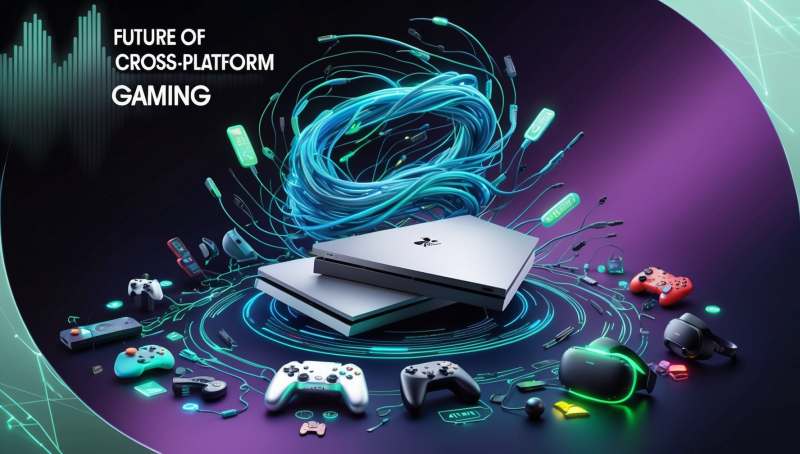Future of Cross-Platform Gaming: A Comprehensive Analysis

The gaming industry is undergoing a transformative shift towards cross-platform compatibility, reshaping how players interact with games and each other. This evolution is not merely a technical advancement but a fundamental change in the gaming landscape, influencing gameplay mechanics, functionality, aesthetics, and the social dynamics of gaming communities.
Unified Gaming Worlds: Merging Platforms and Experiences
The concept of unifying gaming worlds across different platforms has moved from a futuristic idea to a tangible reality. Players can now engage in the same game environment whether they're on a console, PC, or mobile device. This unification breaks down traditional barriers, allowing for a more inclusive gaming ecosystem. Developers are leveraging this trend to create expansive worlds that feel consistent regardless of the platform, ensuring that gameplay experiences remain immersive and cohesive.
Innovations in Gameplay Mechanics Across Devices
Adapting gameplay mechanics to suit various devices is a significant challenge that developers are addressing with innovative solutions. For instance, touch controls on mobile devices require different design considerations compared to keyboard and mouse inputs on PCs or controllers on consoles. Developers are creating adaptive control schemes and customizable interfaces to ensure that players have optimal control regardless of their device. This adaptability enhances the player's connection to the game, making the experience more intuitive and enjoyable.
Advancements in Functionality and Cross-Platform Features
Functionality is a critical aspect of cross-platform gaming, encompassing features like cross-save, cross-progression, and cross-play. Cross-save allows players to transfer their game progress between devices seamlessly, while cross-progression ensures that achievements and unlocked content remain consistent. Cross-play enables players on different platforms to play together, fostering a more connected and dynamic community. These features require sophisticated backend systems and collaboration between platform providers, but the result is a more flexible and player-centric gaming experience.
Enhancing Aesthetics for Diverse Hardware
Delivering high-quality visuals and audio across devices with varying capabilities is a complex task. Developers must optimize game assets to perform well on both high-end PCs and less powerful mobile devices without compromising the game's artistic vision. Techniques like scalable graphics settings, adaptive resolution, and cloud-based rendering are employed to maintain aesthetic consistency. Audio design also plays a crucial role, with soundscapes tailored to different hardware configurations to preserve the immersive quality of the game.
Networking Technologies and Infrastructure Improvements
The backbone of cross-platform gaming lies in robust networking technologies and infrastructure. With the increasing demand for real-time multiplayer experiences, servers must handle vast amounts of data with minimal latency. Innovations like edge computing and advanced data compression algorithms are being implemented to enhance connectivity. Additionally, the adoption of 5G networks is set to revolutionize mobile gaming by providing faster and more reliable connections, further blurring the lines between traditional gaming platforms.
Overcoming Development and Security Challenges
Developing cross-platform games presents unique challenges, particularly in ensuring compatibility and security. Different platforms have distinct operating systems, hardware specifications, and security protocols. Developers must write code that functions seamlessly across these environments, often requiring the use of platform-agnostic programming languages and engines. Security is paramount, as cross-platform integration can expose games to new vulnerabilities. Implementing rigorous security measures and regular updates is essential to protect both the game and its players.
The Influence of Cloud Gaming on Accessibility
Cloud gaming is emerging as a significant driver in making cross-platform gaming more accessible. By offloading processing tasks to cloud servers, players can experience high-quality gaming on devices that would otherwise be incapable of running such games. This technology democratizes access to gaming, allowing a broader audience to participate regardless of their hardware limitations. Services like Google Stadia, NVIDIA GeForce Now, and Microsoft's xCloud are at the forefront of this movement, signaling a shift towards device-agnostic gaming experiences.
Social Dynamics and Community Evolution
The social aspect of gaming is amplified through cross-platform capabilities. Players can connect with friends across different devices, expanding their social networks and fostering diverse communities. In-game communication tools, shared leaderboards, and cross-platform guilds or clans contribute to a more interconnected player base. This evolution challenges developers to create social features that are intuitive and engaging, enhancing the overall community experience.
Economic Models and Monetization Strategies
Cross-platform gaming opens new avenues for monetization and economic models within games. The increased player base provides opportunities for larger in-game economies, more substantial microtransaction revenue, and broader adoption of subscription services. Developers and publishers must balance monetization strategies to ensure they are fair and appealing across different platforms. This includes synchronizing in-game purchases and ensuring that players receive consistent value regardless of their device.
Regulatory Landscape and Industry Standards
The expansion of cross-platform gaming brings regulatory considerations to the forefront. Issues related to data privacy, especially with cross-border data transfers, require compliance with laws like GDPR and CCPA. Industry standards are evolving to address these concerns, with organizations working towards unified guidelines for cross-platform data handling. Additionally, rating systems and content regulations may need to be harmonized across platforms to provide consistent information to consumers.
Impact on Game Design and Development Practices
The shift towards cross-platform compatibility influences fundamental aspects of game design and development practices. Developers are adopting new methodologies, such as agile development and continuous integration, to accommodate the complexities of cross-platform projects. Game engines like Unity and Unreal Engine are evolving to provide better support for multi-platform deployment. This evolution encourages innovation in game mechanics and storytelling, as developers explore ways to create experiences that resonate across diverse devices.
Emergence of Cross-Platform Esports and Competitive Play
The world of esports is also adapting to the cross-platform paradigm. Competitive games are enabling players from different platforms to compete on an even playing field. This inclusivity broadens the talent pool and increases audience engagement. Organizers of esports tournaments are developing rules and standards to ensure fairness, such as standardizing input methods or creating separate divisions for different platforms. This evolution has the potential to significantly grow the esports industry by making it more accessible and diverse.
Technological Synergies and Collaborative Innovations
Collaboration between technology companies is essential for the success of cross-platform gaming. Hardware manufacturers, software developers, and network providers are working together to create compatible systems and standards. Initiatives like cross-platform development kits and shared APIs facilitate this collaboration. These synergies not only improve the gaming experience but also drive technological innovation in areas like graphics processing, network optimization, and user interface design.
User-Centric Design and the Demand for Personalization
As players become accustomed to cross-platform experiences, their expectations for personalization and customization increase. User-centric design approaches are becoming more prevalent, with developers focusing on creating interfaces and experiences tailored to individual preferences. Features like customizable control schemes, accessibility options, and personalized content recommendations enhance user satisfaction. Meeting these demands requires a deep understanding of user behavior and preferences across different platforms.
Future Prospects and Potential Developments
The future of cross-platform gaming is ripe with possibilities. Emerging technologies like virtual reality (VR) and augmented reality (AR) are poised to integrate with cross-platform systems, offering immersive experiences that transcend traditional gaming boundaries. Artificial intelligence (AI) could play a significant role in creating adaptive gameplay and personalized content. Moreover, the continued advancement of cloud computing and network infrastructures will further reduce technical barriers, making high-quality gaming accessible to an even wider audience.
















